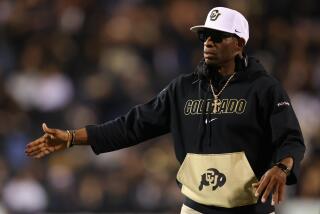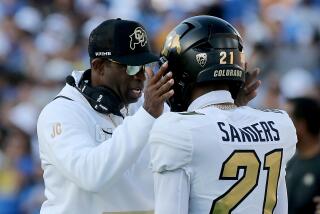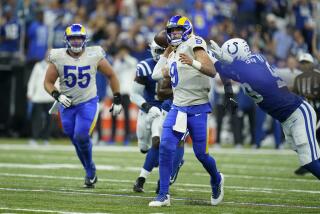Sanders puts jolt in Colts
A key defender to watch in Sunday’s Super Bowl will be Indianapolis safety Bob Sanders, who has the potential to almost single-handedly shut down Chicago’s offense.
At 5 feet 8, 206 pounds, Sanders blends in and out of the Colts’ defensive schemes like a low-flying ninja, stuffing running backs for losses and breaking up passes all over the field.
With a knee injury limiting Sanders to four games during the regular season, Indianapolis’ defense lacked punch against the run, giving up an average of 5.3 yards a carry and 173 rushing yards a game.
The results have been much different in the playoffs.
With Sanders in the lineup for three playoff games, the Colts are giving up 3.6 yards a carry and 73.3 rushing yards a game. And, after giving up 22.5 points a game during the regular season, they are at 16.0 in the playoffs.
A big reason for the turnaround has been the return of Sanders, who adds a different dimension to Indianapolis’ base defense because of his ability to make plays against the run and pass.
On one play, Sanders may line up like a linebacker to help against the run but drop back into coverage once the ball is snapped. Then, on the next play, Sanders may stand 15 yards back from scrimmage before the snap but still be able to make a tackle in the backfield.
In the seven games Sanders has played this season, the Colts have given up an average of 125 rushing yards and forced 19 turnovers. In the 12 games Sanders has missed, they have given up 175.6 rushing yards and forced only 15 turnovers.
Sanders’ versatility makes him so valuable for the Colts, who will make shutting down Chicago’s running game a priority.
Throughout the playoffs, the Bears’ combination of running backs Thomas Jones and Cedric Benson has been a force. With center Olin Kreutz controlling the middle of the line and guard Roberto Garza and tackle Fred Miller providing power blocking on the right side, Chicago has rushed for 294 yards and five touchdowns in two playoff games.
To combat the Bears’ running game, expect Sanders to crowd the line of scrimmage and give Indianapolis an “eight-men-in-the-box” look, especially on first down.
When this happens, Sanders often will match up against fullback Jason McKie, who has been a dominant blocker throughout the playoffs for the Bears.
If Sanders is able to win this battle, Chicago will have trouble running and that will play into the Colts’ defensive plan -- to make the Bears pass with quarterback Rex Grossman.
Despite his lack of size, Sanders also provides an intimidating presence in the middle of the Colts’ secondary against the pass -- but not because he’s the hardest hitter. Sanders keeps receivers on their toes because he always seems be in the right place to make a play.
Summary: When Indianapolis knows a team has to throw, defensive ends Dwight Freeney and Robert Mathis are nearly impossible to block because of their speed. This not only allows the Colts to get a pass rush without blitzing but it also forces offenses to utilize extra blockers to protect the quarterback.
The Bears will not hesitate to use maximum protection in order to give Grossman time to throw, but that will minimize the number of receivers running patterns that the Colts will have to defend.
That’s when Sanders becomes dangerous. Imagine a shorter version of Pittsburgh’s Troy Polamalu, only with less hair.
But Sanders can be blocked. If Kreutz can move Indianapolis nose guard Anthony McFarland and allow left tackle Ruben Brown room to pull, Chicago may be able to get wide enough running lanes to give Sanders trouble. That would then leave the Colts vulnerable against play-action passes.
More to Read
Go beyond the scoreboard
Get the latest on L.A.'s teams in the daily Sports Report newsletter.
You may occasionally receive promotional content from the Los Angeles Times.










